June 16, 2009 – Moments after entering a multiplayer game, Section 8 sends you plummeting through the upper atmosphere and tearing through the sky as you approach your personally selected drop zone. Landing with a bang and ripping a crater in the battlefield, your character arrives on the field of conflict. It’s only 20 seconds in, and already Section 8 has proven that it has some awesome new tricks up its sleeve that instantly separate it from the herd of “me too” first-person shooters.

Most noticeable is the custom spawn point selection. No longer will players be relegated to pre-chosen spots where they can re-enter the battle after death. Players can select their own spawn points anywhere on the map. Anywhere on the battlefield is a potential spawn point, though some areas close to enemy strongholds will have anti-aircraft guns that can destroy you before landing. We’re also told that this mechanic will have some tactical uses as well. Not only will talented players be able to deftly pilot themselves behind enemy lines, but a precision drop could be used to take out a pesky sniper as your crash landing serves as a more than suitable means to dispatch a stationary sharpshooter.
Though Section 8 obviously places a high value on fun factor and explosive action, it never comes at the expense of strategy. So, while the jetpacks featured so prominently in multiplayer are fantastically fun to use and make for some jaw-dropping “wow” moments, they also boast a huge array of tactical uses. This seems to be the overarching philosophy behind Section 8, the successful combination of action and strategy. More frenetic action than Battlefield, more strategy than Halo.
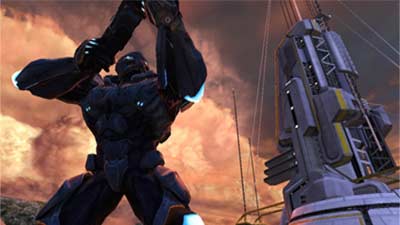
On the strategic end of the spectrum, Section 8 also offers an expansive variety of choices for players to select from when designing their pre-battle load-out. Similar to Call of Duty 4, before a match starts the player customizes the equipment they will be bringing into the battle. This ranges from offensive choices such as a primary weapon and melee weapons, to passive options such as armor plating and stealth abilities. The idea is to allow the player to choose how they want to play the game, without the rigidity of a set class structure like Team Fortress 2. If you want to play an unstoppable, armor-clad, heavy weapons wielding killing machine those options are there. Or, if you want to play as a nimble, stealthy assassin, that’s also a possibility.
As an expansion to the load-out option, the player also has the ability to call down for equipment in the middle of a battle. A menu can be brought that allows the player to call in equipment and vehicles. The types of things you can call for depend on the amount of points you have in that match, which are awarded based on your performance in the match. This system instantly draws comparisons to Counter-Strike. These aerial drops don’t come without their own set of challenges. Players can’t be too cavalier about when they’re calling for equipment, because the drop ship itself can be shot down if there are too many enemies or anti-aircraft guns nearby.
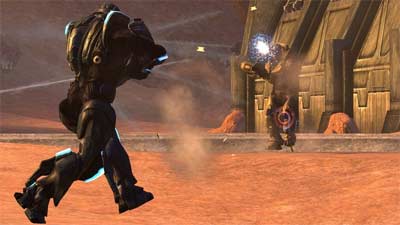
The demo that was on display at E3 was limited to just multiplayer, and it only showcased the Deathmatch game type. The level was a vast rolling desert with a large military complex that could be controlled by either team. That team would then have the option of building anti-aircraft gun emplacements to protect them from enemies that could drop straight into the base. The base could be reclaimed, but the attackers are at a huge disadvantage against the fortified opposition, and are likely to take heavy casualties in their attack.
The name “Section 8” comes from an old real-world military regulation that requires a soldier be dismissed from duty if he is deemed mentally unfit. Due to their obvious propensity for insane stunts (well, what else would you call skydiving into an epic battle from 100,000 feet in the air?) the unit that takes center stage in the game has earned the nickname Section 8. This squad is called upon to intervene in a situation which sees two opposing galactic powers locked in conflict. One of these factions, the Arm of Orion, has been up to no good in the outer rims of the galaxy, conquering planets and adding to their empire. The EDF, essentially the galactic government, decides that this behavior cannot be allowed and as such sends in the soldiers of Section 8 to put a stop to it.
The developers on the project (TimeGate Studios, the developer behind the F.E.A.R. Expansion packs) are still choosing to keep Section 8’s single-player under wraps for the time being, but what was shown of the multiplayer easily elevated Section 8 as one of the most impressive multiplayer games on display at E3.
Game Features:
Free… Freefalling.
How Awesome Is That?
February 26, 2009 – Acrophobia is defined as the fear of heights. In spite of my lack of “traditional” credentials or training, I like to consider myself an amateur psychologist. I don’t think it’s the heights that bother people, it’s the fall. Or maybe the sudden stop at the end. In either case, in my professional opinion, Alex Corde is insane.
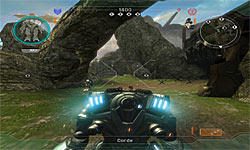
Anyone who spends their days swan diving through the stratosphere is a few chutes short of a safe landing. For Corde, and the other Section 8 operatives, a swim through the clouds is just another day above the office. Section 8 is the newest IP from SouthPeak Games and the first for development partner TimeGate. SouthPeak hasn’t been the most successful publisher since it first dipped its toe in the next-gen pool. Despite a series of creative games (and partnerships with a half dozen developers) SouthPeak has harvested lukewarm receptions from critics and gamers alike. Section 8 may be just the cricket to turn this publisher into a real boy.
On paper the concept is fairly familiar. Two factions deadlocked in an armed conflict in a distant future on a world very reminiscent of our own, if not Earth 2. This particular story tells the tale of a young galactic civilization (think the Republic). The darker of the two factions, the Arm of Orion, has been busy attacking and conquering the planets on the outer reaches of the galaxy. Of course, such behavior cannot be tolerated in a polite galactic society, and the EDF, the established governmental order of the galaxy (think the Senate), calls in the dedicated men and women of Section 8 to kick some Orion arse.
It may seem to be a by-the-numbers scenario for a sci-fi FPS, but the second you see Corde and his crew of armored infantry suit up and freefall toward a hotzone, it becomes clear that this isn’t your daddy’s FPS (assuming your dad is a gamer). In fact, this unique mechanic is one of the most interesting aspects of gameplay, and the trailers are creating a buzz. The action in question is called “burning in” and it’s the quickest way to enter the battlefield. At the beginning of conflict, presumably after some cinematics, players will be treated to a high-speed first-person view of the rapidly approaching ground. Though it’s definitely not something we’ve seen before, it’s already making a mark, and burning in also has tactical uses.
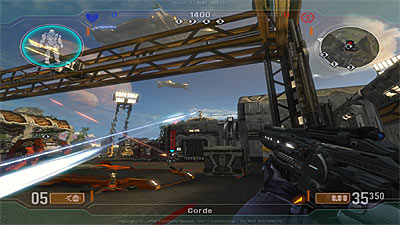
TimeGate has actually managed to revamp the whole “spawning” formula that we’ve gotten used to in games from Halo to Call of Duty. Typically in multiplayer, snuffed gamers wait a few moments only to respawn at some randomly selected point on the map. This, of course, leaves players vulnerable to roaming enemies who take potshots at players they happen to come across. By maneuvering your federations drop ship, players will actually be able to direct their own respawn location.
In order to balance the gameplay, gamers will still face some difficulties. When nearing the ground, soldiers will have to activate jetpacks at the right time or splat. The resulting crater will mean weakened shields for hapless troops.
In Section 8, gamers will be able to take charge of elements on the battlefield called capture points. These elements provide bonuses that correspond to their military application; e.g. communications arrays provide increased radar capabilities, while cannons can be used as antiaircraft guns. Once captured, players can use their new abilities against the enemy. AA guns can pick off enemies while they are burning in. This can force enemies to drop soldiers further from conflict and offers a tactical advantage. It’s a very interesting take on the old formula, and it adds depth to the run-and-gun multiplayer of most shooters. In addition, these capture points will provide players with requisition points that allow you to access new vehicles, weapons, and armor.
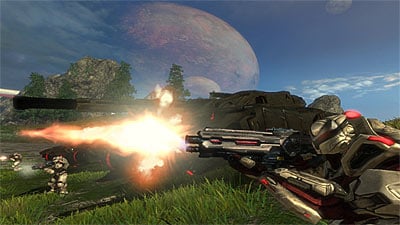
Terrain reportedly stretches for miles, which is a good thing, considering the expansive armored combat gamers can expect. Character classes are adjustable via active and passive boosts. Active boosts are weapons and gadgets that players equip and use in battle (any of which can be knocked off by taking damage). Passive boosts provide intangible enhancements like speed and mobility to give you the upper hand. Gameplay will center mostly on FPS action. Section 8 features three modes: single, multiplayer, or instant action- and multiplayer and instant action modes can provide additional replay value with Dynamic Combat Missions. These objectives (ranging from assassinations to destruction objectives) reward players with additional requisition points for their respective missions.
Multiplayer has been confirmed at up to 16 players (32 on PC), and early screenshots and trailers look awesome. Look for an impact crater on September 30, 2009.
Game Features:
